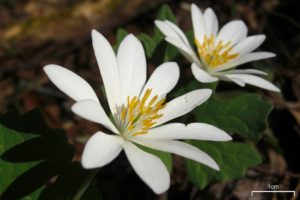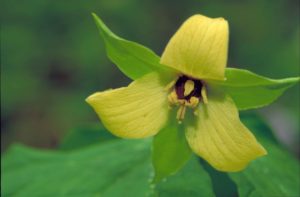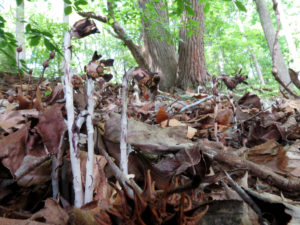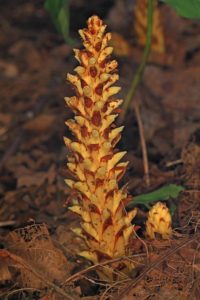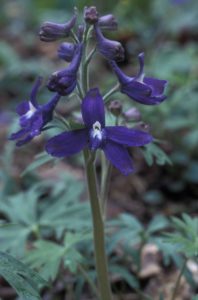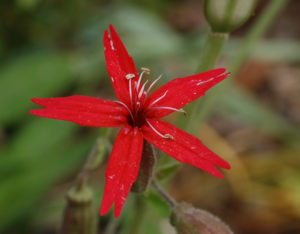I gotta admit, I stole that title from a Dolly Parton song of the same name. One of my many, many favorite Dolly songs. As a matter of fact, every time I see wildflowers, I think of her. They have so much in common. They both thrive in the Mountains, are very attractive and right now, are bustin’ out all over!
Our mountains are home to an estimated 100,000 species of living things and that includes as many as 1400 species of wildflowers. Far, far too many to discuss here so we are going to talk about the more common, the more familiar and the Dolly-Parton-like plants of the wildflower world. Those plants that are extravagant, blatantly gaudy or uniquely attractive.
Spring Beauty and Bloodroot
One of the early bloomers is the Spring Beauty. These delicate little flowers sometimes cover hillsides like a pink snowfall. But you need to hurry, there blooming time is almost over especially in the lower elevations.
Another early bloomer is the Bloodroot. This plant has big round leaves and a beautiful white blossom that blooms
as early as March. The Bloodroot can handle early spring chill because its leaves will wrap around the stem to conserve heat. Again, you should already be out there enjoying this plant before the blooms are gone by April’s end.
The Trout Lily is included among those early bloomers. The mottled patterns on the leaves resemble speckled trout
found in the streams flowing through the valleys and coves. The flower is yellow with long slim petals which bend backwards in a graceful arc. It grows from March through May as high up as 6,000 feet so some late bloomers may be around at higher altitudes into June.
The Abundant Trillium
Depending on which source one goes to, there are eight, maybe nine or as many as ten varieties of trilliums in the Appalachians and they all bloom early, from March through June.
At the lower elevations you’ll find the Yellow Trillium even though it sometimes masquerades with other colors. This is one of the first trilliums of the season to bloom and does so from as early as middle March through May.
The most common trillium is the Large Flowered Trillium, so named because it has, well, a large white flower. The flower of some of these plants actually improves with age, turning from the bright white of youth to a soft pastel pink as they age.You’ll find the Large Flowered Trillium from under 1,000 feet to the 3,500 foot elevations on the slopes and along creeks.
Another common trillium is the Wakerobin. This darkly attractive maroon or deep red bloom is an enigma. It looks great, but smells really foul!
Unique Flower Varieties
The mountains are home to some unusual plants such as Indian Pipe, Squaw Root and Fairy Wand.
The Indian Pipe usually grows up to eight inches tall in small clumps. It is odd looking and can be several different colors all the way from it’s usual pale white to yellow to pink and on rare occasion, blue. The single flower is almost translucent and kinda hangs down. The slightest breeze sets it nodding.
The Squaw Root, is also known as cancer root because it was believed to have some curative effect on cancer. Another name for this plant is Bear Corn probably because it resembles an ear of corn and maybe the person that named it fancied bears nibbling away at this parasitic plant. It will remind one of an elongated pine cone. Squaw Root is a parasite of tree roots, especially oak trees.
The Fairy Wand is a type of lily that is readily identified and aptly named. A long stem (wand) grows up out of a cluster of leaves and is covered with densely packed tiny flowers.
Another “different” looking plant that is unmistakable is the Jack In The Pulpit. This plant has a cylindrical cone with a flap at the top surrounding the actual flower inside. That flower is the “Jack” and the bract, the sheath, is the pulpit. This plant likes moisture and can grow from a foot to more than three feet tall. It is found at the lower altitudes from March through June.
Rhododendron
No description of Appalachian wildflowers could be even partially complete without mention of Rhododendrons, especially the Queen of the Rhody’s, the Catawba Rhododendron and the Flame Azalea.
The Catawba Rhododendron and other rhododendrons along with mountain laurel are two
of the most prolific plants in the mountains. The rhododendrons grow from 8 to 12 feet and sometimes even taller, attaining tree-like heights. The two plants often grow in enormous thickets, especially on ridges and summits. Rhododendrons grow along creek beds and at every elevation. They aren’t just spring bloomers, growing and blooming well into summer at the higher elevations.
Summer Flowers
The Flame Azaleas grow solo and in clusters. The flowers are quite showy, vase-shaped
and are red, orange or yellow. They also bloom into summer beginning in April and at higher elevations last into July. They prefer drier open areas and can be very thick on balds and ridges.
It’s too bad we must limit the number of wildflowers we can talk about here because there
are so many and all worth experiencing in their natural settings, the Appalachian Mountains. We didn’t get to the Anemones, the Wild Geraniums, Pink Lady’s Slipper, Columbine and the spectacular Larkspur. We left out the Jewel Weed, Chicory, Bee Balm, Butterfly Weed and Dutchman’s Breeches. Also passed over were the Wood Sorrel, Dwarf Iris, Mayapple, Indian Pink, squirrel corn, phlox and hundreds of others.
Fire Pink
We will, however, mention the one wildflower I like to compare to Dolly; the most Dolly-like Fire Pink. The Fire Pink has so many of Ms Parton’s attributes. It is always very bright, showy and conspicuous. It is a bit gaudy and
extremely appealing. Every body loves them and like Dolly, it is enduring. The blooming lasts for months from April through June, sometimes into July.
Leave No Trace
As always, admire ‘em, enjoy ‘em and preserve ’em with photos but never, ever, pick a single bloom.
There are thousands of other people who want to enjoy all the beauty and visual pleasures these wonders of Nature provide.
Besides, if you’re in a state or federal park or forest, it’s a crime!
As the saying goes take only pictures and memories; leave nothing but foot prints. And leave those only on marked trails.


